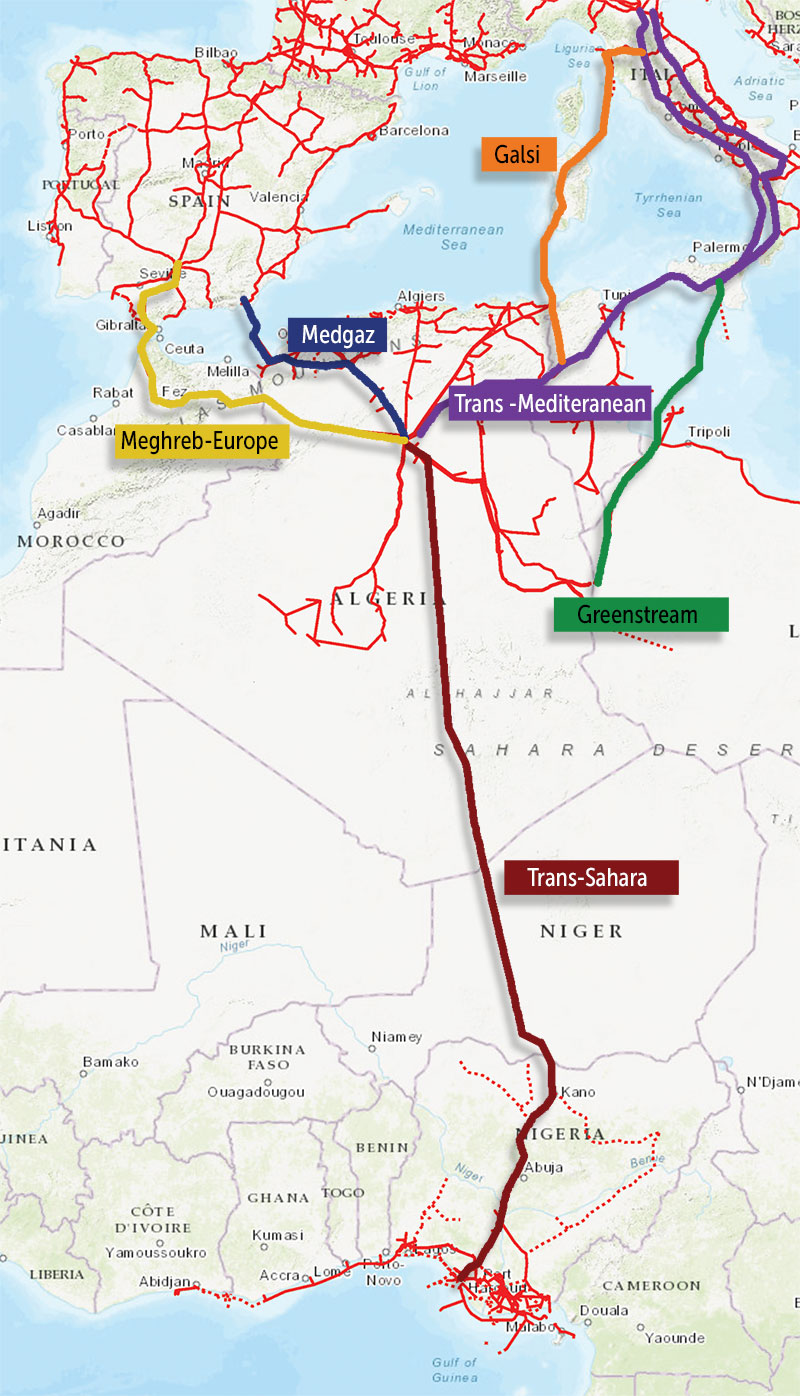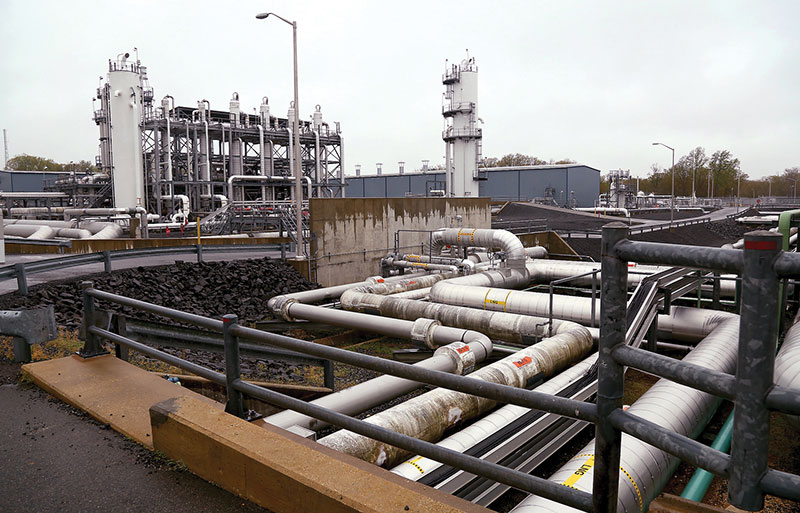June 2021, Vol. 248, No. 6
Features
Hopes Renewed on Nigeria-Morocco Pipeline
By Nicholas Newman, Contributing Editor
In February, Mohammed VI, the King of Morocco, and Muhammadu Buhari, the president of Nigeria, agreed to fast-track the Nigeria-to-Morocco (NTM) subsea natural gas pipeline project.
In so doing, they have signed the death knell of the alternative, the long-standing 2,565-mile (4,128-km) overland Trans-Saharan pipeline (TSP) proposal.
The ambitious $25 billion, 3,517-mile (5,660-km) NTM natural gas pipeline and the $12 billion, 2,485-mile (4,000-km) overland TSP pipeline proposals are designed to capitalize on Nigeria’s abundant natural gas supplies. With proven reserves of 203 Tcf (5,761 Bcm) and annual gas production of approximately 2,000 Bcf (57 Bcm), pipeline exports make economic sense.
Rationale for NTM
Supplying the growing European market with natural gas from West Africa was the original rationale for these two proposed long-distance pipelines. The TSP was first proposed as far back as the 1970s, but it laid dormant until July 2009 when it received renewed backing from Algeria, Niger and Nigeria, attracted by rising prices and demand from Europe.
Dogged by security concerns and the long-standing challenge of the Sahara Desert, the proposal for the TSP once more abated.
Meanwhile, Europe had diversified its gas supply to embrace Russia with the construction of Nordstream 1, supplying Germany in the north, and the more recently opened Trans-Adriatic Pipeline, delivering gas from central Asia to southern Europe.
These pipeline supplies have been augmented by the construction of liquid natural gas import regasification plants to receive supplies from the United States, the eastern Mediterranean and the Middle East, with ongoing European investment in energy efficiency, renewables and energy storage. Therefore, market opportunities for West African gas are likely to decline further.
Access to affordable and secure energy is a precondition for the economic development of West Africa. Burgeoning population growth in the eight coastal African countries that make up West Africa, from Morocco in the north to Nigeria in the south, underpins the 2016 NTM pipeline proposal.
A rapidly growing market of 400 million people and improvements in energy infrastructure provided the impetus for February’s joint decision to fast-track the Nigerian Morocco pipeline project.
Pair of Projects
The TSP was designed to cross the Sahara Desert, a large and mostly unoccupied space offering few market opportunities along its way to Europe. In detail, the TSP would have linked the gas pipeline networks of both Nigeria and Algeria, from where existing Trans-Mediterranean pipelines connect with Spain and Italy.
Despite massive military aid provided by French, British and American forces fighting local terrorist groups such as Al-Qaeda in Algeria and Boko Haram in Niger, and northern Nigeria security concerns, along with a lack of market opportunities combine to end the TSP project.
In contrast, the NTM pipeline is designed to bring Nigerian gas to every coastal country in West Africa (Benin, Togo, Ghana, Cote d’Ivoire, Liberia, Sierra Leone, Guinea, Guinea-Bissau, Gambia, Senegal, and Mauritania), ending at Tangiers in Morocco before reaching Cádiz in Spain.
It would be an extension of the existing 421-mile (678-km) West African Gas Pipeline (WAGP), which already connects Nigeria with Benin, Togo and Ghana.
The existing WAGP is a regional, high-pressure gas transmission system, built to export Niger Delta gas from the Lagos Beach terminal in Nigeria to Ghana, via Benin and Togo. The existing WAGP is the first such pipeline to be installed in sub-Saharan Africa.
The NTM project could yet provide improved energy security to Europe, but its main focus and raison d’tre lies in providing the West African countries along its route with readily available gas to feed the new gas power generation plants being built in this power-starved region.
Cheap, secure and reliable gas translates into reliable and affordable electricity, which is the lifeblood of economic development and provision of employment for a rapidly growing workforce. In turn, this also could reduce the pressure for northward migration to Europe.
On completion, this pipeline offers Ghana, Mauritania, Morocco and Senegal the opportunity to either explore or develop their offshore gas fields, to service their domestic markets and neighbors as well as to export. In fact, many important gas discoveries have been made off West Africa in recent years, and there are likely to be more such finds along the route of the NTM pipeline.
One thing is clear, the NTM project could contribute to solving West Africa’s main problem, namely, the shortage of reliable, affordable and environmentally friendly energy. As recently as 2020, the World Bank reported that only 50% of the region’s population enjoyed access to some form of electricity.
Once this pipeline is complete, it is expected to contribute to the development of economic sectors such as food processing and fertilizers, and simultaneously improve the competitiveness of exports among the African countries.
Challengers to NTM
In common with its rival, the NMP faces several short- to medium-term challenges, the most important of which is concerns of security, vandalism and supply disruptions.
The existing Nigerian gas pipeline, which delivers gas to the WAGP, has suffered numerous acts of sabotage from Niger Delta militants, which makes it difficult for Nigerian gas producers to meet contractual commitments to customers in neighboring countries, leading Ghana to supplement piped gas imports by developing LNG import facilities. Moreover, between January and November 2020, 142 incidents of Boko Haram insurgencies in North Eastern Nigeria were recorded.
The subsea sections of the WAGP have suffered damage from vessels as well, which has interrupted gas supplies and forced operators to declare force majeure provisions (clause that suspends [and may end] performance of obligations in which a party is prevented from performing by events outside its control).
Longer term, questions as to the commercial viability of the NTM pipeline have been raised in light of the expected decline in demand for fossil fuels, initiated by the Paris accords, ongoing improvements in energy efficiency and the increasing competitiveness of renewables and energy storage.
It is apparent that the original hopes of supplying Europe with gas needs to take a backseat. If this project is completed, the main purpose will be to facilitate the economic development and prosperity of the region as well as enable West Africa to meet its climate change goals.







Comments